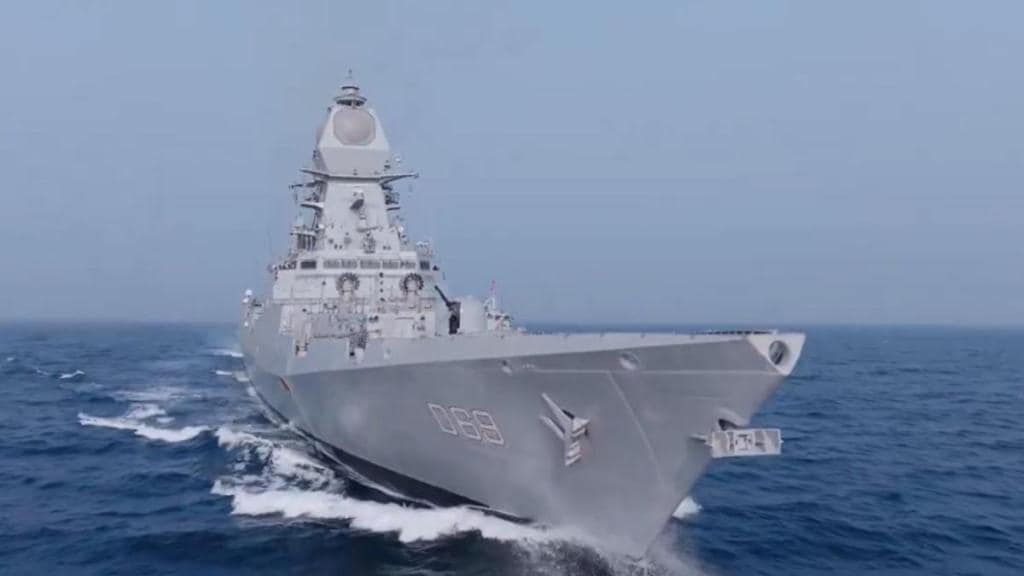On Wednesday, in the pressence of Prime Minister Narendra Modi and Defence Minister Rajnath Singh, Indian Navy warships INS Surat, INS Nilgiri and INS Vaghsheer were commissioned at the Naval Dockyard in Mumbai.
The commissioning of the three frontline naval combatants will strengthen the country’s efforts towards being a global leader in defence and augment its strength towards self-reliance, PM Modi said in a post on X on Tuesday.
On the commissioning of three frontline naval combatants INS Surat, INS Nilgiri and INS Vaghsheer, Defence Minister Rajnath Singh says, “The historic commissioning of INS Surat, INS Nilgiri and INS Vaghsheer, is a testimony not just to the Indian Navy, but also to India’s growing strength in the Indian Ocean Region. Although the Indian Ocean Region has always been important from a geo-strategic and economic point of view, but in today’s rapidly changing environment, it has become even more important. Today we can say that the importance that the Atlantic Ocean used to have in the past has shifted to the Indian Ocean today…”
INS Nilgiri, the lead ship of the Project 17A stealth frigates, is presided over by Captain Nitin Kapoor, this commissioning today (Jan 15, 2025) marks a critical milestone in India’s maritime modernisation. It also signals New Delhi’s strategic intent to navigate the complexities of an increasingly contested Indo-Pacific region.
Legacy Meets Modernity
INS Nilgiri, named after the Nilgiri Hills, carries forward a legacy steeped in naval tradition. Its predecessor, the original INS Nilgiri, commissioned in 1972, was the lead ship of India’s first indigenous frigate class. This new-generation vessel embodies India’s maritime heritage while embracing cutting-edge technology.
Built under the Project 17A programme by Mazagon Dock Shipbuilders Limited (MDL) in collaboration with Italy’s Fincantieri, the frigate features stealth technology, advanced sensors, and weaponry. Its crest depicts the Indian Bison, or Gaur, a powerful symbol of resilience and strength, also associated with the 54th Infantry Division of the Indian Army, known as the Bison Division. This shared emblem highlights India’s growing emphasis on jointness between its armed forces—a key enabler of modern warfare.
A Maritime Power Asserting Itself
The commissioning of INS Nilgiri comes at a time when the Indo-Pacific region is witnessing heightened strategic competition. As China continues its aggressive naval expansion and economic dominance through its Belt and Road Initiative (BRI), India is reinforcing its naval capabilities to secure its interests in the Indian Ocean Region (IOR).
INS Nilgiri’s formidable arsenal, which includes BrahMos cruise missiles and Barak-8 air defence systems, enhances India’s ability to deter adversaries and project power. Equipped with advanced stealth features and anti-submarine warfare capabilities, the ship strengthens the Navy’s capacity to secure critical sea lanes of communication (SLOCs) and counterbalance China’s presence in the region.
Strategic Autonomy and Indigenous Capability
INS Nilgiri is part of a series of seven frigates under the Project 17A programme, over 70% of which is indigenously sourced. This reflects India’s commitment to achieving strategic autonomy and reducing its dependence on foreign defence imports under the “Make in India” initiative.
The timing of this induction is particularly significant. As a member of the Quadrilateral Security Dialogue (Quad), alongside the United States, Japan, and Australia, India is expected to play a pivotal role in shaping the region’s security architecture. The commissioning of INS Nilgiri aligns with this vision, enabling India to contribute effectively to collective security initiatives in the Indo-Pacific.
Maritime Diplomacy and a Message to Rivals
India’s naval modernisation also serves as a powerful instrument of maritime diplomacy. Through joint exercises, port visits, and humanitarian assistance operations, the Indian Navy has emerged as a stabilising force in the region. The commissioning of INS Nilgiri reinforces this narrative, projecting India as a responsible maritime power committed to upholding a free, open, and inclusive Indo-Pacific.
At the same time, the induction of such advanced platforms sends a clear message to rivals. To China, it signifies India’s readiness to counterbalance its assertive behaviour, particularly in the IOR. To Pakistan, which remains reliant on Chinese military support under the China-Pakistan Economic Corridor (CPEC), it highlights the Indian Navy’s superior maritime capabilities and strategic reach.
Jointness and the Future of Warfare
The symbolism of commissioning INS Nilgiri on Army Day, alongside INS Surat, a destroyer, and INS Vagsheer, a submarine, is hard to ignore. It underscores India’s growing emphasis on jointness—the integration of land, sea, and air operations—as the cornerstone of its defence strategy. The Indian Bison, common to both the ship’s crest and the Bison Division of the Indian Army, further highlights the collaborative ethos driving India’s armed forces.
A Strategic Vision for the Indo-Pacific
The induction of INS Nilgiri heralds a new chapter in India’s maritime journey. As geopolitical fault lines deepen in the Indo-Pacific, India is positioning itself not just as a participant but as a pivotal force shaping the region’s future. The ship’s cutting-edge technology and operational capabilities reflect India’s readiness to assert its strategic autonomy and protect its maritime interests.
As the seas grow ever more contested, INS Nilgiri embodies India’s determination to safeguard its sovereignty, foster regional stability, and champion a multipolar Indo-Pacific. In doing so, it reinforces the nation’s status as a credible and capable maritime power—a force for security and cooperation in an uncertain world.

